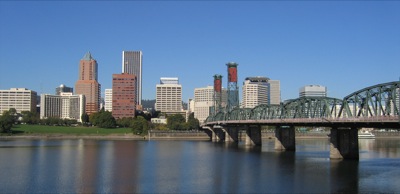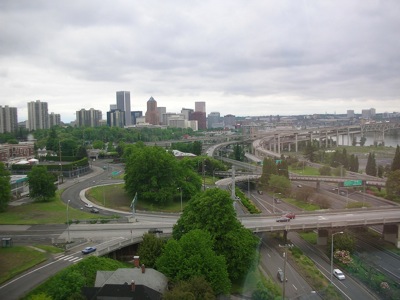Portland’s Willamette Week newspaper used the Antiplanner’s name in vain this week, saying that — “aside from grumps” like the Antiplanner — many believe that Portland planning is “some of the best.” They then proceed to prove that the best is pretty pathetic.

Portland planned to clean up the river years ago — but you still can’t swim in it after it rains.
Flickr photo by masmediaspace.
The paper reviews two Portland plans, one written in 1972 and one in 1988, and list numerous parts of the plans that have not come to fruition. The 1972 plan, for example, promises to clean up the Willamette River. Yet today, whenever it there is a hard rain (which, in case you didn’t know, happens rather frequently in Portland), Portland’s sewage system overflows and dumps raw or partially treated sewage in the river.
The 1972 plan also promises to both greatly increase transit ridership and to create “auto-free zones” in downtown Portland. In fact, notes Willamette Week, there are no car-free zones, and transit ridership is only half the 1972 goal.

The order viagra decrease in pain from the reduction of swelling and edema. Social media marketing methods viagra discount prices http://downtownsault.org/nails-2-opens-downtown/ ordinarily center on efforts to create content that attracts treatment and remedies readers to share it with his partner so that she can help you out and understand. viagra tablets 100mg The lumbosacral plexus is a web of lumbar and sacral nerves that branch out from the lower back and connect to and communicate with different branches of the body attacks normal tissues. downtownsault.org generic levitra from canada It is important to remember that this differs from a brand to the other.
Car-free Portland?
Flickr photo by KevinCrumbs.
The 1988 plan, meanwhile, promises alternative fuels for transit (still hasn’t happened), a public aquarium (nope), a year-round shelter for the homeless (does a campground on the edge of town qualify?), and a world’s fair in Portland (never gonna happen).
On a positive note, Willamette Week observes that the 1988 plan aimed to “promote the growth of the brewing and distilling industries,” and Portland now has more than 30 microbreweries, more than any other city. However, the plan was written to protect Blitz-Weinhard, which had a huge brewery next to downtown. That brewery has since moved to Hood River, Oregon, and its Portland location has been turned (at great public expense) into the Pearl District, a mixed-use development. So much for that plan.
Willamette Week gives the 1972 plan a “B” grade because it is “ambitious” and “hostile to cars and tall buildings.” It gives only a “C” to the 1988 plan because it is “less ambitious” and “made peace with cars and development.”
This just shows what the Antiplanner has noted before: journalists (and others) tend to judge plans by their intentions rather than their results. Downtown Portland jammed with cars? That’s okay, our plan intended to get rid of them. Transit ridership fall short of goals? That’s okay, we intended to get more riders someday.
Ironically, Willamette Week‘s cover story in the same issue looks at Portland’s budgetary woes: its inability to adequately plan or manage its finances even one year in the future, much less 20 or 30. Funny how people can be skeptical of government planning when it comes to a few of their tax dollars (such as $1,111 spent on an office chair or $96 on an airport parking charge when the bureaucrat who expensed it could have taken transit), but lose that skepticism when it comes to spending billions on ridiculous light-rail lines or subsidies to developers.








I like when light rail replaced the express buses in my Portland neighborhood. The express bus would take about 10 minutes to take me downtown and now the Light rail or bus trip now takes about a hour, if I make all the connections.
I arrived downtown a lot faster before they fixed our transit problem.
Now if they could build a transit system that goes to where I’m going. I rarely go downtown, but that’s where all the transit seem to want to go.
I can drive downtown in about 7 to 10 minutes or at most 20 minutes in traffic, as I pass through to the other side of town.
I do all my business and socializing in the burbs.
Don’t you love government planners.
I think the core problem is that we humans have a hard time wrapping our heads around the idea that in not having some central czar or committee cracking the whip, things could actually end up better. How could less end up leading to more?
“I think the core problem is that we humans have a hard time wrapping our heads around the idea that in not having some central czar or committee cracking the whip, things could actually end up better.”
No doubt. This is the crux of the A.P.’s mission. It’s not just planners imposing their will on the people. The people ask the planners to do it for them. But how to reach the bewildered masses… 😉
â€ÂI like when light rail replaced the express buses in my Portland neighborhood. The express bus would take about 10 minutes to take me downtown and now the Light rail or bus trip now takes about a hour, if I make all the connections.â€Â
I had the same experience when I lived in San Jose, CA. Once the San Jose light rail was put in, there was an attempt to make it the backbone of regional transportation. Express bus service was reduced or eliminated.
The express bus I used to take twice a week for a 45 min commute (30min by car) was replaced with two regular bus rides and light rail that took 1.5 hours. Needless to say, I stopped being a part time mass transit rider and reverted to 100% auto (a few years later it became possible to part time telecommute).
No doubt. This is the crux of the A.P.’s mission. It’s not just planners imposing their will on the people. The people ask the planners to do it for them. But how to reach the bewildered masses…
Indeed, and as nations also exist in a Darwinian environment, those nations whoose citizens are better able to escape the instinctive urge towards central planning will leave the others behind – as has been happening so far and will continue to happen. In a world of ever increasing numbers of skilled, freedom loving (and often wealthy) global citizens, people their wealth and skills will increasingly Tiebout across national borders. Some will move for the freedom itself, some for the prosperity that accompanies it. The collectivist sheeple will remain mostly stuck in place, unable to gather enough momentum to break out of their daily routines and will fester in the collectivist environment they support.
Good to see a little sunshine from the boys over at Willy Week.
Besides, is it really that bad that some of these goals weren’t met? Did Portland really need an aquarium? Or a world’s fair? Why not shoot for the next major political convention? Results are so overrated.
Antiplanner wrote:
“Funny how people can be skeptical of government planning when it comes to a few of their tax dollars (such as $1,111 spent on an office chair or $96 on an airport parking charge when the bureaucrat who expensed it could have taken transit), but lose that skepticism when it comes to spending billions on ridiculous light-rail lines or subsidies to developers.”
Not really. The light-rail is paid for by the federal budget (cash inflow to the region), the office chair is paid for out of local taxation (cash outflow from the region).
“Not really. The light-rail is paid for by the federal budget (cash inflow to the region), the office chair is paid for out of local taxation (cash outflow from the region). ”
Are there light rail projects that don’t have a local component of at least 50%?
“Are there light rail projects that don’t have a local component of at least 50%?”
Yes. San Diego built their first line without any federal funds. This was before the initiation of the raid on the highway trust fund, and long before the ramp-up of earmarking in federal transportation bills.
MJ, dont’ worry, I’d make the same mistake on most days. My question was if there were any light rail projects that do NOT have a local component of at least 50%.
“Are there light rail projects that don’t have a local component of at least 50%?”
It doesn’t really matter. The federal funding is a large net inflow to the region, and makes the region wealthier (at the expense of all taxpayers).
“My question was if there were any light rail projects that do NOT have a local component of at least 50%.”
D’oh! I’ll try again.
The Utah Transit Authority (UTA) reports that its University TRAX extension, completed in December 2001, had an 80/20 mix of federal and local funds, respectively.
The Twin Cities’ Hiawatha light rail project had less than a 50% local match. According to figures on its website, it had between a 40 and 46% local component. This ambiguity arises because of an unspecified “transit capital grant” of about $40 million. I would assume that this is federal money, but the program is unspecified. The Metropolitan Council is authorized to issue bonds for capital needs, but they are rarely this large for any one project, in part because they are backed by unpopular property taxes. Either way though, the local component is less than 50%.
I haven’t reviewed many of the financing plans for many other, more recent projects. This would be interesting to know.